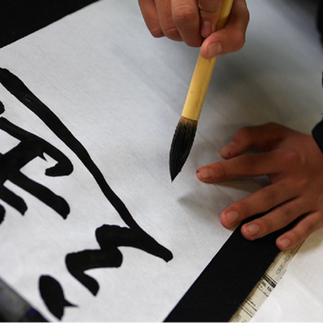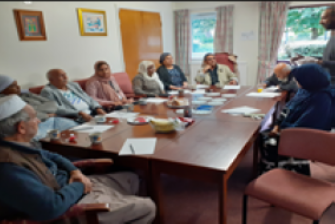Manningham Housing conducted four sessions with a focus on Arabic Calligraphy. The sessions took place at Anchor Court on Thursday mornings. Many of the participants did not know the history of Calligraphy, so they began by sharing the fascinating history of Calligraphy and how it developed. One of the participants from Pakistan was particularly keen to share his own knowledge on Arabic Calligraphy and talked about Sadequain Ahmed Naqvi, the famous contemporary Pakistani Painter who would use Arabic calligraphy in his art.
The first practical workshop used marbling, and everyone enjoyed it. They began to see how art can have a positive impact on mental health. Everyone had their own special piece of marbled paper – it was amazing how unique each one was.
The next exercise was to use watercolors, and in all the sessions, the participants were very engaged in using brushes. There was a lovely atmosphere of everyone working quietly. A mindfulness exercise on gratitude was also conducted.
One of the highlights from the sessions was being able to use the traditional Qalam (a bamboo pen) and hand-mixed ink on specialist paper. Everyone learned that this is a very old method of writing calligraphy and were also given the history of how this ‘dot system’ – Nuqta system developed. Some of the older participants were so pleased to be able to hold a bamboo pen after so many years away from it! (Some had used bamboo pens in school).
Symmetry and pattern were also explored, using rulers and colored pencils to create unique designs using a grid pattern that also linked to calligraphy. Despite using the same design grid, everyone’s results were so different and bright!
Razwan Ul-Haq also introduced everyone to his Bradford 2025 Project on ink making. It was really interesting, he had also given everyone homework to do. Each participant was to bring a rock, stone, or pebble that had significance to them. One of the participants brought a light-colored rock and talked about what it meant to her. Her rock would be crushed by Razwan later to be used as part of the project.
Finally, everyone had a chance to frame their pieces, using the marbled work as the backdrop and carefully choosing what they wanted on the front. Of course, dear Mr. Babakalan felt the need to date his piece. He was very organized throughout the project with dates, addresses, and his name written neatly on all his work. Everyone really loved the end pieces; one of the participants said it looked so professional it was almost as if she had bought it in a shop!
Another very positive outcome was that MHA staff and participants were both able to take part in the artwork, making everyone feel part of the same team. Another positive outcome was that residents who did not know anything about Arabic culture were able to ask about it in a safe place. The MHA team and their customers really got to know each other!







Comments